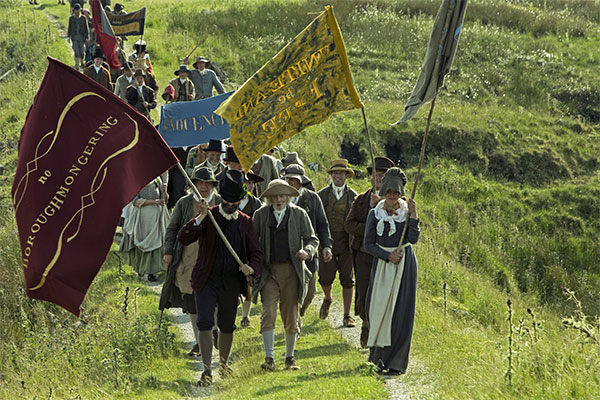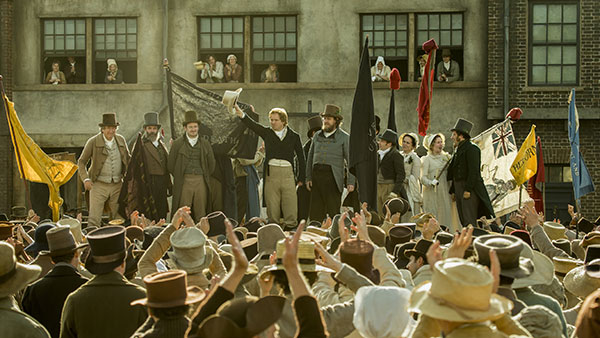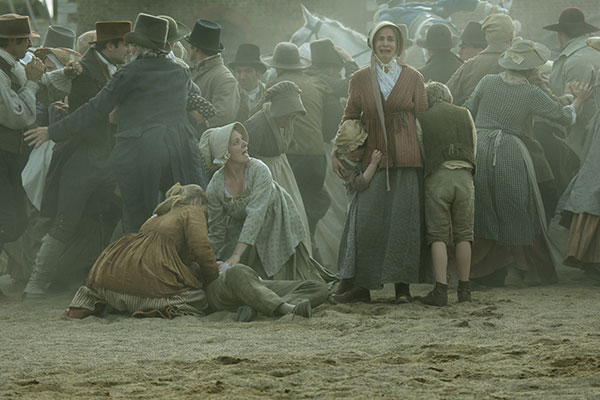Peterloo
Published in Book Reviews, Issue 1 (January/February 2019), Reviews, Volume 27Directed by Mike Leigh
By Eoin Dillon
Mike Leigh’s film Peterloo deals with events in St Peter’s Field in Manchester on 16 August 1819, when between 60,000 and 100,000 organised and disciplined workers, both men and women, from town and field, assembled peacefully to demand parliamentary reform and were sabred down—with perhaps fifteen dead and hundreds wounded—by the Manchester yeomanry and hussars. It was an act of brute class war—Shelley’s Masque of anarchy—and came to occupy a pivotal place in British social and political history. While the evidence suggests that the massacre was not initiated by the London government—the north of England was under the command of General Sir John Byng, who had taken part in the suppression of the 1798 rebellion in Ireland—central government was subsequently keen to play up its association with events. Nationally, however, the terms of engagement changed profoundly, and not until Bloody Sunday, January 1972, in Ireland is there a comparable case of the British state using such reckless and mortal violence domestically against unarmed political protesters. Protesters in the colonies received no such immunity.
Peterloo came out of the intense radical agitation in Britain that arose as the post-Napoleonic Wars slump hit the various trades, the labour force was awash with demobbed soldiers and sailors, and destitution was a common fate as the corn laws ensured high bread prices. Earlier, in 1812, Nottingham handloom weavers had sought to protect their livelihood by smashing oversized machines and were dealt with ruthlessly; Luddism became a byword for all that was backward-looking. Post-war radicalism drew on multiple and deep sources. It was neither organisationally nor intellectually coherent; rather it was an admixture of constitutional and physical force, Jacobin, Deist-Painite, conservative high-minded working men and women, middle-class Whigs, the committed and the ephemeral, often tragic and sometimes farcical, but kept together by a widely circulating radical press. In the aftermath of Peterloo, despite holding the moral high ground, the radical leadership split and the repressive force of the Six Acts was brought to bear; the movement virtually collapsed.

Above: ‘No boroughmongering’, ‘Unite and be free’—men and women assemble for the demonstration in St Peter’s Field on 16 August 1819.

Above: The speakers on the platform reflected an admixture of constitutional and physical force, Jacobin, deist-Painite, conservative high-minded working men and women, middle-class Whigs, the committed and the ephemeral, often tragic and sometimes farcical.
That should have been that, but it wasn’t. During the 1820s something was going on out of sight. Radicalism re-emerged in the run-up to the Great Reform Bill agitation of 1832, and it did so in a much more coherent and forceful insurgent working-class form, to the point where E.P. Thompson described it as the most significant factor in British political life. An older Painite, artisanal rhetoric of individualism was being replaced by an analysis that saw exploitation as inherent in the labour process itself—a proto-labour theory of value. I spent some time in the British Library in the early 1980s doing research on Richard Carlile, a Painite tinsmith and publisher who was on the platform at Peterloo. It was the era of Mrs Thatcher, the hunger strikes, the Brixton and Liverpool riots, the crushing defeat of the Labour Party in the 1983 general election and the miners’ strike of 1984–5. The question was: would another radicalism emerge a decade later, out of the ashes, to challenge the new orthodoxy? Instead we got Tony Blair, who had no intellectual or personal roots in the labour movement, bar a very ambitious wife. For two decades old labour values were moribund, socialism equated with eccentricity. But something was going on. Out of the ashes of the financial crash, a mass Labour Party supporting Jeremy Corbyn and nationalisation has come onto the scene in a Britain divided as never before by Brexit, class, geography, age, liberalism and conservatism, as well as colour and ethnicity.
Where does Mike Leigh’s Peterloo fit into all of this? He has made a film for our times, if you are English, and northern English at that. It opens with a bugler making his way back from the Napoleonic Wars to his home in Manchester. This is Manchester just as it becomes the major world exporter of cotton goods, but in slump as the war economy closes down. Leigh has made no concessions to reflecting a modern Manchester in his Manchester of 1819; it is an exclusively English place. His one expansion on earlier narratives is his bringing to the fore the role of women in the open political world, and the ensuing class and educational divisions that this reveals. And it is a film that glories in late eighteenth- and early nineteenth-century English language: the oratory, verbatim, rolls off the tongue as historical characters engage in heartfelt political persuasion of multitudes who address one another in their own vernacular. If much of Georgian popular politics has a certain theatricality, then some of this seems well suited to the stage.

Above: The aftermath—perhaps fifteen were killed and up to 700 wounded.
The historical recreation is detailed. Orator Hunt, Samuel Bamford and Dr Joseph Healy cleave to their contemporary representations: vain, down-to-earth and loyal to the cause respectively. The need to tread a fine line, for fear of prosecution, between expressing physical-force popular sentiments and urging peaceful constitutional agitation is observed sharply. So is the culture of deference: south of England politicians fawn to majesty, north of England magistrates and gentry fawn to south of England authority. The flip side of this is class division, expressed in murderous hatred and contempt for ‘the lower orders’. But there is no clear message for our time. The plebeian language of the free-born Englishman is a major part of north of England support for Brexit, even as Boris Johnson and Jacob Rees-Mogg publicly embody class entitlement in forms worthy of James Gilray.
The film ends with the prince regent, the future George IV, lounging in luxury, attended by suitably obsequious Lords Liverpool and Sidmouth, prime minister and home secretary respectively, as he dictates his thanks to magistrates for restoring tranquillity to a place with which he is barely acquainted. At the other end of England, in a rainswept graveyard, the pastor says the prayers for the dead over the open grave of a protester. But that is to end it on a note of defeat. In E.P. Thompson’s account, Samuel Bamford ended his days somewhat differently. At the massacre’s end, he searched desperately for his wife before joining hundreds of people streaming in disarray along the road to the upland districts. He caught up with a great number of the Middleton and Rochdale contingents: ‘I rejoined my comrades, and forming about a thousand of them into file, we set off to the sound of fife and drum, with our only banner waving, and in that form we re-entered the town of Middleton’. Neither Peterloo nor the Brexit referendum result quite closed things down as completely as they were meant to.
Eoin Dillon is a scholar of twentieth-century African history.
















